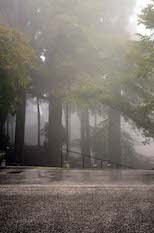Jodo Wasan 97
Out of compassionate concern for the people of the land,
Master Saicho of Mount Hiei said that
One should utter 'Namu-amida-butsu'
As a spell for eliminating the seven calamities.
Dengyo Daishi
This is an extension or refinement of the previous verse (96). The seven calamities are associated with fear of injury and death, sometimes taking the form of mere superstition. These are eclipses of the sun and moon, meteorites, lightning and wildfire, heavy rainfall and flood, storms and gales, drought, and war. As was the case for the previous verse, it is from the fear of such things that people of nembutsu are delivered.
This principle of Pure Land Buddhism is actually established in the Sukhavati Vyuha Sutra itself. Here we are told that the vast and transcendent resonance of the Bodhi tree in the Pure Land endows freedom from the fear of disease. It describes how we can still live as well as we can in the face of such afflictions but without being paralysed by anticipatory or actual experience of them. By the power of the Primal Vow we can accept the vicissitudes of life and live well.
~~~
Dengyo Daishi (Saicho) was born in Shiga Prefecture in 767. If it were not for him and the fact that he introduced the T'ien t'ai (tendai) School of Buddha Dharma to Japan then, of course, we may never have heard of Jodo Shinshu. Shinran Shonin moved to Hiei-zan, the T'ien t'ai headquarters, to deepen his study and practice of the dharma shortly after being ordained at the age of nine by Jichin, the chief priest of Shoren'in in Kyoto. It is possible that if Shinran Shonin had not undergone his apparently anguished search for salvation in the context of the challenging discipline and demanding spiritual excercises at Hiei-zan he may never have felt the need to seek the help of Honen Shonin who introduced him to the Other-Power way.
Saicho was ordained when he was fourteen and was sent to China to study. When he returned he brought back the T'ien t'ai teachings along with knowledge of Zen and the esoteric practices. The T'ien t'ai is named for the mountain in China where the 'northern branch' of the school was established. After a life spent serving both the imperial court, the dharma and his country, Saicho died in 822 at Hiei-zan.

T'ien t'ai encompasses all developments of the Buddha Dharma through the ages and its teaching tends more in the direction of the inclusiveness rather than the excision of ideas which may be deemed unorthodox. Thus Saicho played a major role in a rapprochement between Shinto and the Buddha Dharma. T'ien t'ai bases its mission and hermeneutics on the Lotus Sutra; but the Nirvana Sutra, which was so important to Shinran, also plays an important role. Of especial significance in T'ien t'ai doctrine is the identity of the apparent 'material' world with the absolute, the dharma body. One might say that it emphasises the immanence of the ineffable in the temporal but I think that this kind of language - the best we have - sets up an inappropriate dualism. The doctrine is capable of serious abuse and misunderstanding and could prove dangerous in the wrong hands. Hence, Saicho set up a process of rigorous and arduous training for Hiei-zan monks.
I think that one can see the influence of the T'ien t'ai approach to the dharma in quite a lot of Shinran's thought. A good example of this is his appreciation of shinjin. It seems to me that Shinran sees it not as 'belief', or self-generated 'faith', but as the manifestation of the dharma body in an ordinary person. This perspective seems to be very much in keeping with the T'ien t'ai spirit; indeed, it could be said that it is a proof of it. Another striking example is Shinran's use of a broad selection of texts to support his exegesis in the Kyo Gyo Shin Sho. This reminds us of the eclectic nature of T'ien t'ai. On the other hand, it would not be correct to assert that Shinran was consciously promulgating T'ien t'ai doctrine. Indeed, he was not an exponent of the Lotus Sutra in any way and, of course, his principal influence was Honen Shonin.
In this verse, Shinran first points to Saicho's compassion but his main point is to honour the significance of the nembutsu.